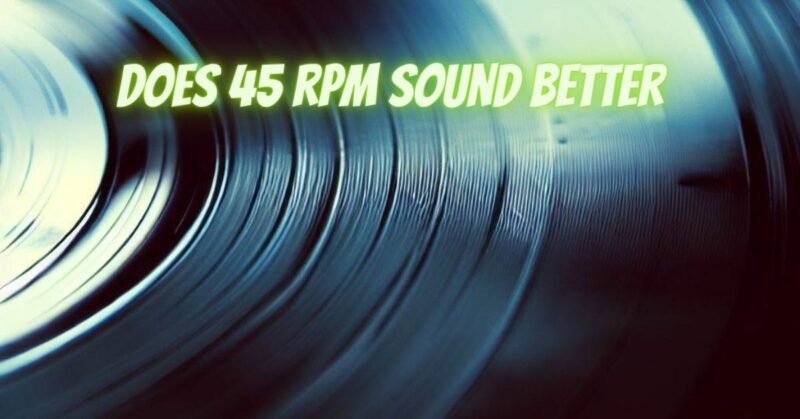In the realm of vinyl enthusiasts and audiophiles, the quest for superior sound quality is a perpetual journey. Amidst the various debates surrounding vinyl playback, the question of whether 45 revolutions per minute (RPM) offers superior sound has stirred considerable discussion. In this exploration, we unravel the intricacies of the 45 RPM format, examining its historical context, technical advantages, and the subjective experiences that shape the perception of sonic superiority.
Historical Significance:
1. The Origin of 45 RPM:
The introduction of the 45 RPM vinyl format dates back to the late 1940s, spearheaded by RCA Victor. Initially designed for singles, the 45 RPM records became synonymous with the burgeoning rock and roll era, offering a convenient and efficient format for single-track releases.
2. Single vs. Album Dynamics:
While the 33 1/3 RPM format became the standard for full-length albums, the 45 RPM format continued to dominate the landscape for single-track releases. The choice between the two formats was often dictated by the nature of the content, with 45 RPM providing a more dynamic and detailed playback for individual songs.
Technical Advantages:
3. Increased Groove Density:
One of the key technical advantages of 45 RPM records lies in the increased groove density. With a smaller circumference per rotation, 45 RPM records can dedicate more space to each individual groove, allowing for finer details and a broader frequency range. This higher groove density contributes to a potentially superior signal-to-noise ratio.
4. Enhanced Dynamic Range:
The combination of higher groove density and increased linear velocity at 45 RPM allows for an expanded dynamic range. This can result in more precise tracking of musical nuances, improved transient response, and a heightened sense of realism in the audio reproduction.
5. Reduced Inner Groove Distortion:
Inner groove distortion, a common challenge in vinyl playback, occurs as the stylus traverses toward the center of the record. The 45 RPM format mitigates this issue by reducing the excursion of the stylus, allowing for a more linear and distortion-free playback, especially on longer tracks.
Subjective Listening Experience:
6. Sonic Purity and Audiophile Appeal:
Audiophiles often gravitate towards 45 RPM vinyl records for their perceived sonic purity. The format’s ability to convey intricate details and capture the full spectrum of musical dynamics appeals to those who prioritize an immersive and authentic listening experience.
7. Genre-specific Preferences:
Preferences for 45 RPM can be genre-specific. Audiophiles and collectors of jazz, classical, and acoustic genres, where the subtleties of the performance are paramount, often favor the 45 RPM format for its ability to faithfully reproduce the nuances inherent in these genres.
Practical Considerations:
8. Cost and Accessibility:
While 45 RPM records are lauded for their sonic benefits, they come with practical considerations. They are often more expensive to produce, and the selection of titles available in this format may be limited compared to the more ubiquitous 33 1/3 RPM releases. Cost and accessibility factors play a role in the decision-making process for collectors and enthusiasts.
9. Equipment Compatibility:
Another practical consideration is the compatibility of playback equipment. Not all turntables and tonearms are designed to handle 45 RPM records. Ensuring that the equipment is capable of accommodating this format is essential for those looking to explore the sonic advantages it offers.
In the ongoing pursuit of superior sound quality in vinyl playback, the 45 RPM format emerges as a compelling contender. Its historical significance, technical advantages, and the subjective experiences of audiophiles collectively contribute to the allure of this format. While the debate over whether 45 RPM offers truly superior sound remains subjective, the undeniable appeal lies in its potential to unlock a heightened level of sonic excellence, inviting enthusiasts to embark on a captivating journey through the grooves of meticulously crafted vinyl records.


